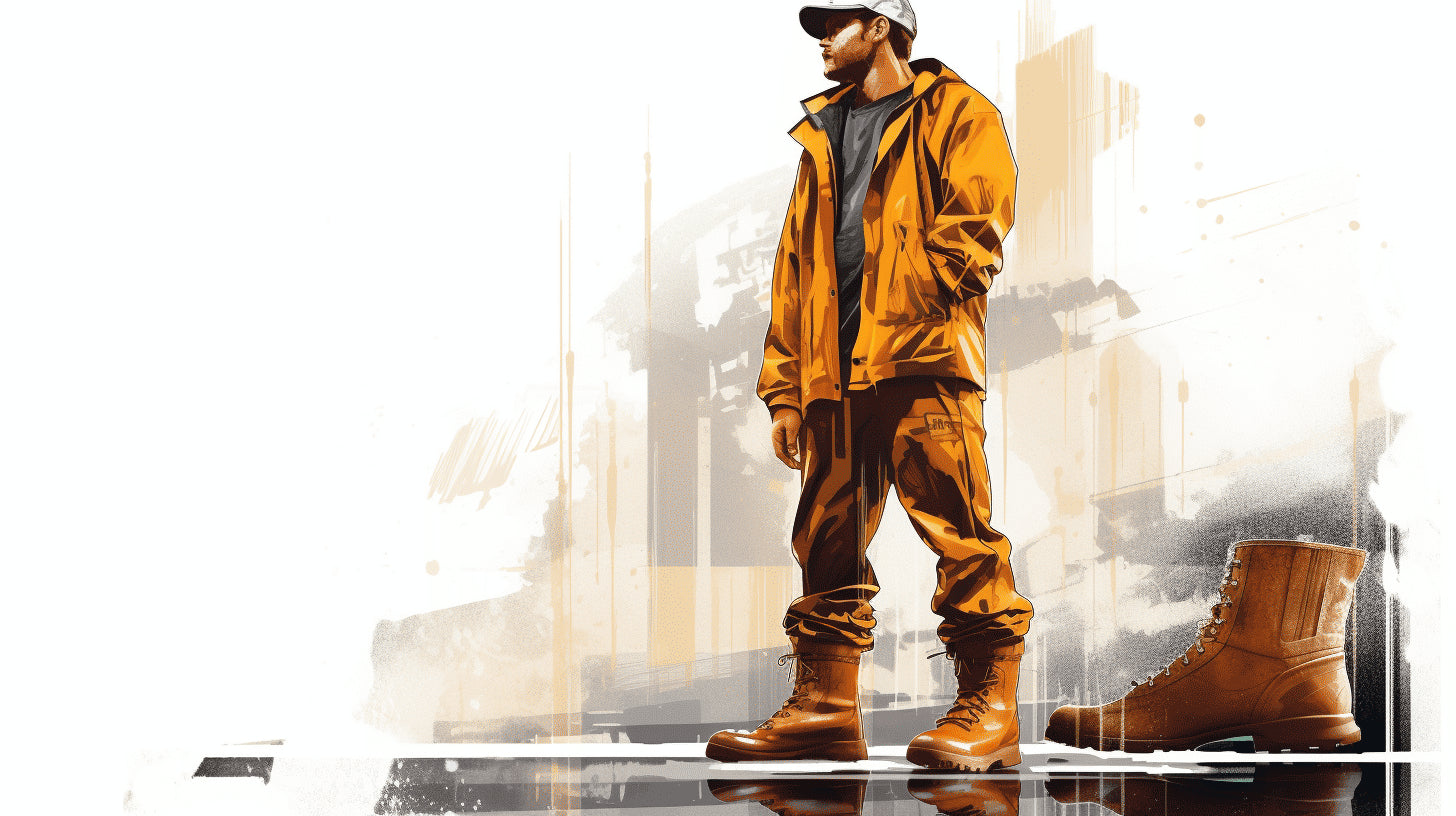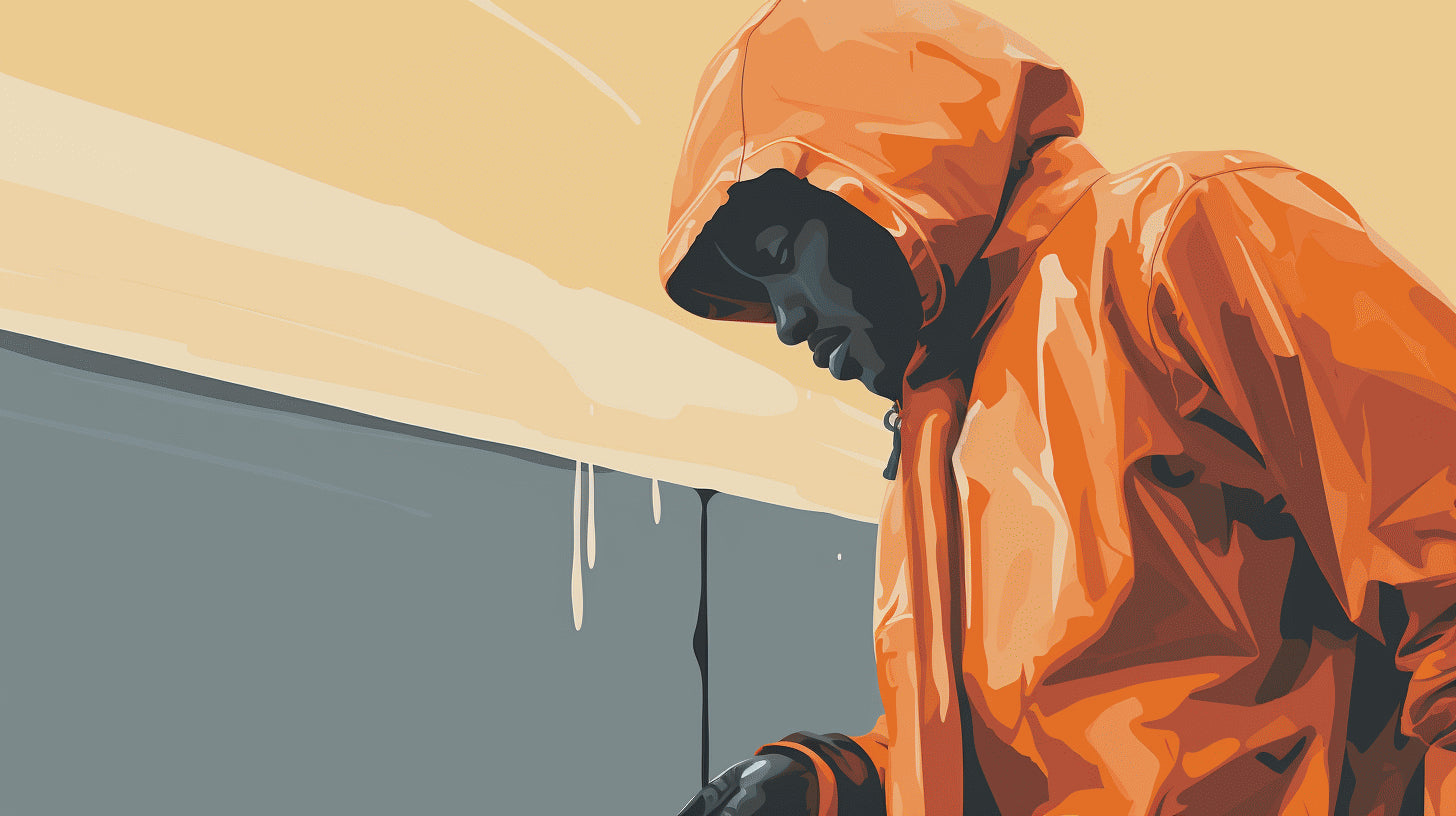Picture this: A construction site buzzing with activity, workers tirelessly erecting structures against cloud-heavy skies. A sudden downpour might cause a flurry of activity again, but this time it's workers scrambling for cover, temporarily abandoning their work. Rain doesn't just dampen the surroundings; it dampens productivity too. And in the construction industry, where time is money, reduced productivity is a costly issue. That's where robust rain gear for construction labor comes into play: not just as a means to stay dry, but also as a tool to keep work moving during adverse weather. In our article, we will dive into the significance, types, features, and maintenance of boundary-pushing rain gear in the realm of construction. Join us as we explore how the right gear can help combat tough weather, promoting construction efficiency and safeguarding worker health, no matter the forecast.
Rain is often viewed romantically in popular culture but for construction laborers, it's a difficult and inclement reality. It poses both challenges and risks for those who must continue their work despite the weather. Understanding the consequences of these conditions, construction firms are recognizing the essential need for adequate rain gear for their workforce. This section unfolds the importance of rain gear for construction labor by addressing its role in protection against elements, maintaining work efficiency, and considerations for health and safety.
Protection Against Elements
When you’re outdoors braving the elements, it's paramount to stay dry and warm. And that's where the significance of suitable rain gear steps in.
- Waterproof clothing: One of the most essential pieces of rain gear is a waterproof suit, complete with a jacket and pants. These are made from materials specially treated to repel water, keeping the wearer dry even during heavy rains. This simple yet effective attire can make a significant difference in comfort and health.
- Cover for tools and equipment: Along with personal protection, safeguarding tools and equipment from rain is equally essential. Water can cause rust and dysfunction in machinery, rendering them useless or even dangerous. Waterproof covers and tarps ensure their safety and smooth functionality.
- Rain boots: Specially designed waterproof boots keep feet dry and provide much-needed traction on slippery surfaces, thereby preventing accidents.
Maintaining Work Efficiency in Adverse Weather
Adverse weather conditions can greatly impact workers' morale and efficiency. However, adequate rain gear allows not just protection but also functional convenience, which can help maintain agility and productivity.
The right gear can help workers remain comfortable in harsh weather, and a comfortable worker is likely a more productive one. This includes waterproof gloves for better grip, aptly sized clothing that doesn’t hinder movement, and special glasses to improve vision in poor light.
Health and Safety Considerations
Finally, the importance of rain gear for construction labor transcends its functional assistance—it significantly contributes to maintaining workers' health and safety. Prolonged exposure to cold and wet environments can lead to ailments like pneumonia and hypothermia. Workers might also risk slipping and falling due to slippery surfaces, potentially leading to severe injuries.
By considering these aspects, it comes to light that providing the right rain gear for construction labor is an investment that positively impacts productivity, workers' health and morale, and endures the longevity of tools and equipment. Thereby firmly establishing it as an indispensable part of construction operations.
When it comes to construction work, unpredictable weather, including torrential rain, can be one of the major challenges faced by laborers on site. While the downpour can interrupt tasks and delay project timelines, it can also put the health and safety of workers at risk. Therefore, it's important for workers to equip themselves with the right rain gear for sustained efficiency and protection. In this article, we dive into the various types of rain gear necessary for anyone working in the construction industry.
Rain Jackets and Coats
The obvious first line of defense against the rain is a sturdy, water-resistant jacket or coat. The best options for construction workers are not only made from durable, waterproof material but also come with ample room for maneuverability. Some features to look for include:
- Fully sealed seams to prevent leakage.
- High collars and adjustable hoods for head and neck protection.
- Multiple pockets for utility and convenience.
- Breathable fabric to prevent sweating and discomfort.
High-Visibility Rain Gear
Due to reduced visibility during a downpour, it is critical for construction laborers to use high-visibility rain gear. High-vis rainwear usually features bright, neon colors and reflective stripes, making the wearer visible even in low light conditions. This gear often includes jackets, vests, and overalls.
Waterproof Boots
Keeping the feet dry is fundamental for maintaining comfort and preventing potential health hazards such as infections or hypothermia. Waterproof boots designed for construction work are made from robust material like leather or rubber. They are usually high-cut to prevent water from entering the boot and are equipped with slip-resistant soles for better traction on muddy or wet surfaces.
Waterproof Gloves
Construction work involves the constant use of hands, making gloves an essential piece of rain gear. Waterproof gloves are designed to keep hands dry without compromising dexterity or grip. A moisture-wicking lining is another feature to consider, as it can provide additional comfort by drawing perspiration away from the skin.
Hard Hat Rain Gear
Hard hats are mandatory on most construction sites, and rain gear for hard hats is no different. Accessory options like a brim or neck shade can help direct rain away from the face and neck, while typically made from water-resistant material to keep the head dry. Some designs additionally offer slots for attaching earmuffs or visors for further protection.
In summary, investing in good quality rain gear is not only a practical measure but is also key to ensuring the safety and well-being of construction workers. When armed with the right equipment, rain needn't be a formidable opponent - construction labor can continue unhindered, come rain or shine.
When working on a construction site, you never know when the weather will take a nasty turn and get in the way of your progress. Rain may fall unexpectedly, but that doesn't mean the task at hand needs to come to a standstill. To continue working effectively under such unpredictable circumstances, it's essential to possess good quality rain gear. This kind of apparel not only provides the much-needed protection against the rain but also ensures flexibility to move around and perform tasks without feeling restricted or uncomfortable. Here's bridging you to some crucial features to keep in mind while choosing robust rain gear for construction work.
Water Resistance
The whole point of owning rain gear is to remain dry and comfortable during a downpour. Therefore, the degree of water resistance should be the first thing to look at when picking quality rain gear. High-quality rain outfits provide complete resistance against water intrusion, allowing you to continue your construction task fuss-free. The market houses a plethora of fabrics that offer excellent water resistance, such as Gore-Tex® or eVent®, which are known for their efficient water-repellent characteristics.
Durability
In the realm of construction work, the word ‘delicate’ doesn’t exist. Your rain gear should adhere to this rule too. It is important to choose gear that is sturdy enough to withstand not just the heavy rain, but also the overall harsh environment of a construction site. This involves selecting rain gear made from robust materials that can hold up well against the wear and tear of the job site, replicating the unceasing determination services of a structure in progress.
Comfort and Fit
Nobody wants to work in gear that’s uncomfortable or ill-fitting. Much like a well-tailored suit, good rain gear should fit comfortably, without being too tight or too loose, to ensure mobility is not hindered. Furthermore, considering construction work can be strenuous, the chosen gear should prioritize breathability. This means looking for rain gear that incorporates ventilation features—a bonus for when the weather is humid or overly warm.
Visibility Features
Particularly on a construction site, visibility is crucial. A foggy, rainy day can significantly reduce sight range, posing safety risks. Opting for rain gear with safety colors and reflective striping enhances your visibility to others on site. These features are particularly important in low-light conditions.
Ease of Mobility
Rain gear should never limit or restrict your movements. While it's essential to provide ample protection against the rain, good gear also sheathes in enough flexibility and ease of movement. Seek out gear that is designed with articulated knees and elbows. They offer ample room for movement and make it easy to carry out your duties—whether you’re bending, lifting, or climbing—without feeling restricted.
A centurion is only as good as his armor, and the same can be said for a construction worker and his gear. Ensuring you are armed with the right kind of rain gear can be the differentiating factor between a productive workday and a washout. The right gear not only shields you from unpredictable weather conditions but also elevates the overall work experience, creating an environment conducive for efficiency and productivity. It might feel like an uphill task to zero in on the perfect rain gear— but remember, like a well-structured building, a well-geared worker stands tall, strong and resilient under any weather.
Rain gear is an essential investment that plays a role in the overall safety and comfort of construction workers, especially when working in harsh outdoor conditions. Proper maintenance of these pieces ensures long-term use and optimal performance, but how exactly should one go about this?
Cleaning and Storage
Rain gear should ideally be cleaned after each use to remove accumulated dirt and grime. Specialized cleaners as recommended by the manufacturer should be used – this is because household cleaners can seriously degrade the product’s water-repellent properties. After cleaning, rain gear should be left to air dry; never use a machine dryer as this can potentially damage the gear's fabric and compromise its durability.
When it comes to storage, always ensure the gear is clean and completely dry to prevent mildew and to maintain its quality. Store in a cool, dry place free from direct sunlight, which can cause the material to harden or crack over time. And remember:
- Never leave the gear folded or wadded up, to prevent creasing and damage to the layers.
- Using a hanger is advisable for the best shape retention.
Regular Inspection
Adopting a regular inspection schedule plays a crucial part in ensuring the longevity and effectiveness of your construction rain gear. Look out for:
- Wear and tear, such as holes or tears, which could compromise the waterproofing
- Damages to closure systems including zippers and snaps
- Degradation of the garment's water repellency – one clear sign of this is if water stops beading up on the surface
If any of these issues are spotted, prompt repairs should be made, either by following manufacturer’s instructions or enlisting professional help.
Respecting the Product Life Cycle
Every product has a life cycle, and construction rain gear is no exception. Even with optimal care, over time, the product will naturally degrade and lose its efficacy. Once a piece of rain gear reaches the end of its life cycle, it would be best to replace it, as using degraded equipment could risk a worker's comfort and safety.
Remember, the high demands of the construction industry necessitate that all protective gear is functioning optimally at all times. Therefore, regular maintenance, inspection, and respect for the product life cycle should be a priority for every dedicated and safety-conscious worker. By adhering to these rules, you can ensure your rain gear continues to keep you dry and safe amid harsh weather conditions.
As we wrap up, it becomes apparent just how vital rain gear is for construction labor. No matter how inclement the weather, construction projects come with strict timelines. Robust rain gear can be a game-changer, enabling workers to continue their tasks without battling discomfort or risking their well-being.
Rain gear is not just about protection against rain but also courtesy towards the individuals who brave severe climates to build magnificent structures. By safeguarding workers from hazards related to wet environments, such as slipping, visibility issues, or health complications, rain gear substantially increases worksite safety.
When considering rain gear, factors such as water resistance, durability, comfort, visibility, and mobility significantly influence the purchase decision. Remember, the best rain gear is the one that can endure the harshest weather while still offering comfort and ease of movement to the wearer.
Caring for these life-saving pieces of apparel is equally critical. Regular inspection, appropriate cleaning, storage, and respecting the product life cycle can prolong the life of your rain gear.
In a nutshell, potent rain gear is instrumental for construction labor, allowing workers to effectively and safely carry on with their tasks, no matter the weather. After all, isn't it empowering to know that rain does not have to be a showstopper at construction sites?
Frequently Asked Questions
-
What are the essential elements of robust rain gear for construction labor?
Essential elements of robust rain gear for construction labor include waterproof and breathable fabric, sealed seams, adjustable hood, reinforced durability in high-wear areas, and visibility features such as reflective strips.
-
Are there specific rain gear options for different types of construction work?
Yes, there are specific rain gear options designed for different types of construction work. For example, construction workers who need to climb or work at height should consider rain gear with built-in fall protection features.
-
How do I ensure that my rain gear is the right fit for me?
To ensure the right fit of your rain gear, carefully refer to the size chart provided by the manufacturer. It is also helpful to read customer reviews for insights on sizing and consider trying on the gear before making a purchase if possible.
-
How do I properly care for and maintain my rain gear?
Proper care for rain gear includes cleaning according to the manufacturer's instructions, avoiding harsh chemicals or fabric softeners, ensuring thorough drying before storage, and occasional application of a waterproofing spray to maintain water repellency.
-
Can I use my rain gear for other outdoor activities outside of construction work?
Yes, rain gear designed for construction labor can also be used for various outdoor activities such as hiking, camping, and gardening. They provide effective protection against rain and adverse weather conditions.























Leave a comment
This site is protected by hCaptcha and the hCaptcha Privacy Policy and Terms of Service apply.